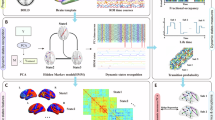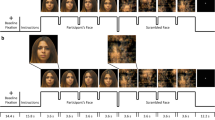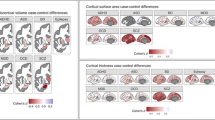Abstract
Body dysmorphic disorder (BDD) is characterized by preoccupation with misperceived defects of appearance, causing significant distress and disability. Previous studies suggest abnormalities in information processing characterized by greater local relative to global processing. The purpose of this study was to probe whole-brain and regional white matter network organization in BDD, and to relate this to specific metrics of symptomatology. We acquired diffusion-weighted 34-direction MR images from 14 unmedicated participants with DSM-IV BDD and 16 healthy controls, from which we conducted whole-brain deterministic diffusion tensor imaging tractography. We then constructed white matter structural connectivity matrices to derive whole-brain and regional graph theory metrics, which we compared between groups. Within the BDD group, we additionally correlated these metrics with scores on psychometric measures of BDD symptom severity as well as poor insight/delusionality. The BDD group showed higher whole-brain mean clustering coefficient than controls. Global efficiency negatively correlated with BDD symptom severity. The BDD group demonstrated greater edge betweenness centrality for connections between the anterior temporal lobe and the occipital cortex, and between bilateral occipital poles. This represents the first brain network analysis in BDD. Results suggest disturbances in whole brain structural topological organization in BDD, in addition to correlations between clinical symptoms and network organization. There is also evidence of abnormal connectivity between regions involved in lower-order visual processing and higher-order visual and emotional processing, as well as interhemispheric visual information transfer. These findings may relate to disturbances in information processing found in previous studies.
Similar content being viewed by others
Log in or create a free account to read this content
Gain free access to this article, as well as selected content from this journal and more on nature.com
or
References
American Psychiatric Association (2000) Diagnostic and Statistical Manual of Mental Disorders: DSM-IV-TR 4th edn. American Psychiatric Association: Washington, DC.
Balodis IM, Lacadie CM, Potenza MN (2012). A preliminary study of the neural correlates of the intensities of self-reported gambling urges and emotions in men with pathological gambling. J Gambl Stud 28: 493–513.
Buhlmann U, Glaesmer H, Mewes R, Fama JM, Wilhelm S, Brahler E et al (2010). Updates on the prevalence of body dysmorphic disorder: a population-based survey. Psychiatr Res 178: 171–175.
Bullmore E, Sporns O (2009). Complex brain networks: graph theoretical analysis of structural and functional systems. Nat Rev Neurosci 10: 186–198.
Bullmore E, Sporns O (2012). The economy of brain network organization. Nat Rev Neurosci 13: 336–349.
Catani M, Schotten Td (2008). A diffusion tensor imaging tractography atlas for virtual in vivo dissections. Cortex 44: 1105–1132.
Creem SH, Proffitt DR (2001). Defining the cortical visual systems: ‘What’, ‘Where’, and ‘How’. Acta Psychol (Amst) 107: 43–68.
Deckersbach T, Savage C, Phillips K, Wilhelm S, Buhlmann U, Rauch S et al (2000). Characteristics of memory dysfunction in body dysmorphic disorder. J Int Neuropsychol Soc 6: 673–681.
Desikan RS, Segonne F, Fischl B, Quinn BT, Dickerson BC, Blacker D et al (2006). An automated labeling system for subdividing the human cerebral cortex on MRI scans into gyral based regions of interest. NeuroImage 31: 968–980.
Dunai J, Labuschagne I, Castle DJ, Kyrios M, Rossell SL (2010). Executive function in body dysmorphic disorder. Psychol Med 40: 1541–1548.
Eisen JL, Phillips KA, Baer L, Beer DA, Atala KD, Rasmussen SA (1998). The Brown Assessment of Beliefs Scale: reliability and validity. Am J Psychiatry 155: 102–108.
Evans MA, Shedden JM, Hevenor SJ, Hahn MC (2000). The effect of variability of unattended information on global and local processing: evidence for lateralization at early stages of processing. Neuropsychologia 38: 225–239.
Fan Y, Shi F, Smith JK, Lin W, Gilmore JH, Shen D (2011). Brain anatomical networks in early human brain development. NeuroImage 54: 1862–1871.
Feusner JD, Hembacher E, Moller H, Moody TD (2011). Abnormalities of object visual processing in body dysmorphic disorder. Psychol Med 41: 2385–2397.
Feusner JD, Moller H, Altstein L, Sugar C, Bookheimer S, Yoon J et al (2010a). Inverted face processing in body dysmorphic disorder. J Psychiatr Res 44: 1088–1094.
Feusner JD, Moody T, Hembacher E, Townsend J, McKinley M, Moller H et al (2010b). Abnormalities of visual processing and frontostriatal systems in body dysmorphic disorder. Arch Gen Psychiatry 67: 197–205.
Feusner JD, Moody T, Townsend J, McKinley M, Hembacher E, Moller H et al (2010c). Abnormalities of visual processing and frontostriatal systems in body dysmorphic disorder. Arch Gen Psychiatry 67: 197–205.
Feusner JD, Townsend J, Bystritsky A, Bookheimer S (2007). Visual information processing of faces in body dysmorphic disorder. Arch Gen Psychiatry 64: 1417–1425.
Girvan M, Newman ME (2002). Community structure in social and biological networks. Proc Natl Acad Sci USA 99: 7821–7826.
Hamilton M (1969). Diagnosis and rating of anxiety. Br J Psychiatry 3: 76–79.
Hamilton M (1960). A rating scale for depression. J Neurol Neurosurg Psychiatry 23: 56–62.
Hanes K (1998). Neuropsychological performance in body dysmorphic disorder. J Int Neuropsychol Soc 4: 167–171.
Hollander E, Wong C (1995). Introduction: obsessive-compulsive spectrum disorders. J Clin Psychiatry 56 (Suppl 4): 3–6.
Honey CJ, Sporns O, Cammoun L, Gigandet X, Thiran JP, Meuli R et al (2009). Predicting human resting-state functional connectivity from structural connectivity. Proc Natl Acad Sci 106: 2035–2040.
Honey CJ, Thivierge J-P, Sporns O (2010). Can structure predict function in the human brain? NeuroImage 52: 766–776.
Insel TR, Cuthbert BN (2009). Endophenotypes: bridging genomic complexity and disorder heterogeneity. Biol Psychiatry 66: 988–989.
Jbabdi S, Johansen-Berg H (2011). Tractography: where do we go from here? Brain Connect 1: 169–183.
Jenkinson M, Bannister P, Brady M, Smith S (2002). Improved optimization for the robust and accurate linear registration and motion correction of brain images. NeuroImage 17: 825–841.
Koran LM, Abujaoude E, Large MD, Serpe RT (2008). The prevalence of body dysmorphic disorder in the United States adult population. CNS Spectr 13: 316–322.
Kotter R, Sommer FT (2000). Global relationship between anatomical connectivity and activity propagation in the cerebral cortex. Philos Trans R Soc Lond Ser B 355: 127–134.
Li W, Zhang L, Arienzo D, Leow A, Feusner JD (2010). Fractional anisotropy differences of the inferior fronto-occipital fasciculus in body dysmorphic disorder. Society for Neuroscience Annual Meeting. San Diego, CA.
Li Y, Liu Y, Li J, Qin W, Li K, Yu C et al (2009). Brain anatomical network and intelligence. PLoS Comput Biol 5: e1000395.
Mancuso SG, Knoesen NP, Castle DJ (2010). Delusional versus nondelusional body dysmorphic disorder. Compr Psychiatry 51: 177–182.
Monzani B, Rijsdijk F, Iervolino AC, Anson M, Cherkas L, Mataix-Cols D (2012). Evidence for a genetic overlap between body dysmorphic concerns and obsessive-compulsive symptoms in an adult female community twin sample. Am J Med Genet B 159B: 376–382.
Morgan VL, Mishra A, Newton AT, Gore JC, Ding Z (2009). Integrating functional and diffusion magnetic resonance imaging for analysis of structure-function relationship in the human language network. PLoS One 4: e6660.
Mori S, van Zijl PC (2002). Fiber tracking: principles and strategies—a technical review. NMR Biomed 15: 468–480.
Morris JS, Friston KJ, Buchel C, Frith CD, Young AW, Calder AJ et al (1998). A neuromodulatory role for the human amygdala in processing emotional facial expressions. Brain 121 (Part 1): 47–57.
Oldfield RC (1971). The assessment and analysis of handedness: the Edinburgh inventory. Neuropsychologia 9: 97–113.
Olson IR, Plotzker A, Ezzyat Y (2007). The Enigmatic temporal pole: a review of findings on social and emotional processing. Brain 130: 1718–1731.
Patterson K, Nestor PJ, Rogers TT (2007). Where do you know what you know? The representation of semantic knowledge in the human brain. Nat Rev Neurosci 8: 976–987.
Phillips KA (2005) The Broken Mirror Edition. Oxford University Press: New York.
Phillips KA (1995). Diagnostic Instruments for body dysmorphic disorder. American Psychiatric Association 148th Annual Meeting. Miami, FL. p 157.
Phillips KA, Coles ME, Menard W, Yen S, Fay C, Weisberg RB (2005). Suicidal ideation and suicide attempts in body dysmorphic disorder. J Clin Psychiatry 66: 717–725.
Phillips KA, Diaz SF (1997a). Gender differences in body dysmorphic disorder. J Nerv Ment Disord 185: 570–577.
Phillips KA, Hollander E, Rasmussen SA, Aronowitz BR, DeCaria C, Goodman WK (1997b). A severity rating scale for body dysmorphic disorder: development, reliability, and validity of a modified version of the Yale–Brown Obsessive Compulsive Scale. Psychopharmacol Bull 33: 17–22.
Phillips KA, Menard W, Pagano ME, Fay C, Stout RL (2006). Delusional versus nondelusional body dysmorphic disorder: clinical features and course of illness. J Psychiatr Res 40: 95–104.
Putnam MC, Steven MS, Doron KW, Riggall AC, Gazzaniga MS (2010). Cortical projection topography of the human splenium: hemispheric asymmetry and individual differences. J Cogn Neurosci 22: 1662–1669.
Rubinov M, Sporns O (2010). Complex network measures of brain connectivity: uses and interpretations. NeuroImage 52: 1059–1069.
Sheehan DV, Lecrubier Y, Sheehan KH, Amorim P, Janavs J, Weiller E et al (1998). The Mini-International Neuropsychiatric Interview (M.I.N.I.): the development and validation of a structured diagnostic psychiatric interview for DSM-IV and ICD-10. J Clin Psychiatry 59 (Suppl 20): 22–33, quiz 34–57.
Shinoura N, Suzuki Y, Tsukada M, Katsuki S, Yamada R, Tabei Y et al (2007). Impairment of inferior longitudinal fasciculus plays a role in visual memory disturbance. Neurocase 13: 127–130.
Stam CJ, Reijneveld JC (2007). Graph theoretical analysis of complex networks in the brain. Nonlinear Biomed Phys 1: 3.
Stangier U, Adam-Schwebe S, Muller T, Wolter M (2008). Discrimination of facial appearance stimuli in body dysmorphic disorder. J Abnorm Psychol 117: 435–443.
van den Heuvel MP, Stam CJ, Kahn RS, Hulshoff Pol HE (2009). Efficiency of functional brain networks and intellectual performance. J Neurosci 29: 7619–7624.
Wang J, Wang L, Zang Y, Yang H, Tang H, Gong Q et al (2009). Parcellation-dependent small-world brain functional networks: a resting-state fMRI study. Hum Brain Mapp 30: 1511–1523.
Watts DJ, Strogatz SH (1998). Collective dynamics of ‘small-world’ networks. Nature 393: 440–442.
Zalesky A, Fornito A, Harding IH, Cocchi L, Yucel M, Pantelis C et al (2010). Whole-brain anatomical networks: does the choice of nodes matter? NeuroImage 50: 970–983.
Zhang TJ, Wang JH, Yang YC, Wu QZ, Li B, Chen L et al (2011). Abnormal small-world architecture of top-down control networks in obsessive-compulsive disorder. J Psychiatr Neurosci 36: 23–31.
Acknowledgements
This work was supported by grants from the National Institute of Mental Health (K23 MH079212 and R01MH093535, Dr Feusner).
Author information
Authors and Affiliations
Corresponding author
Ethics declarations
Competing interests
The authors declare no conflict of interest.
Additional information
Results presented in part at the American College of Neuropsychopharmacology 50th Annual Meeting, Waikoloa, HA, USA, December 2011
Supplementary Information accompanies the paper on the Neuropsychopharmacology website
Supplementary information
Rights and permissions
About this article
Cite this article
Arienzo, D., Leow, A., Brown, J. et al. Abnormal Brain Network Organization in Body Dysmorphic Disorder. Neuropsychopharmacol 38, 1130–1139 (2013). https://doi.org/10.1038/npp.2013.18
Received:
Revised:
Accepted:
Published:
Issue date:
DOI: https://doi.org/10.1038/npp.2013.18
Keywords
This article is cited by
-
Visual training program for body dysmorphic disorder: protocol for a novel intervention pilot and feasibility trial
Pilot and Feasibility Studies (2018)
-
Neurocognitive Functioning in Young Adults with Subclinical Body Dysmorphic Disorder
Psychiatric Quarterly (2018)
-
Mental health: Monsters in the mirror
Nature (2015)
-
Focusing on flaws
Nature Reviews Neuroscience (2013)



